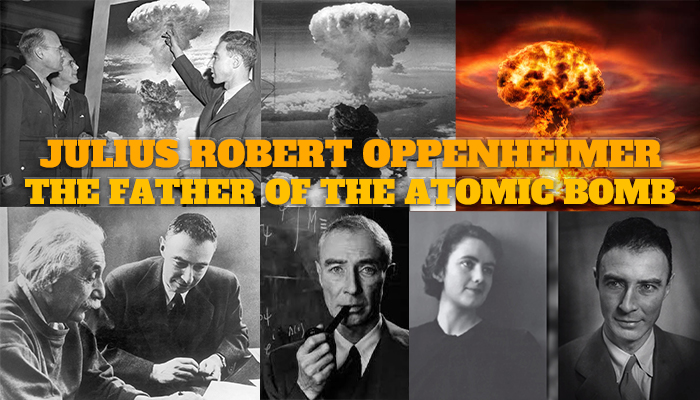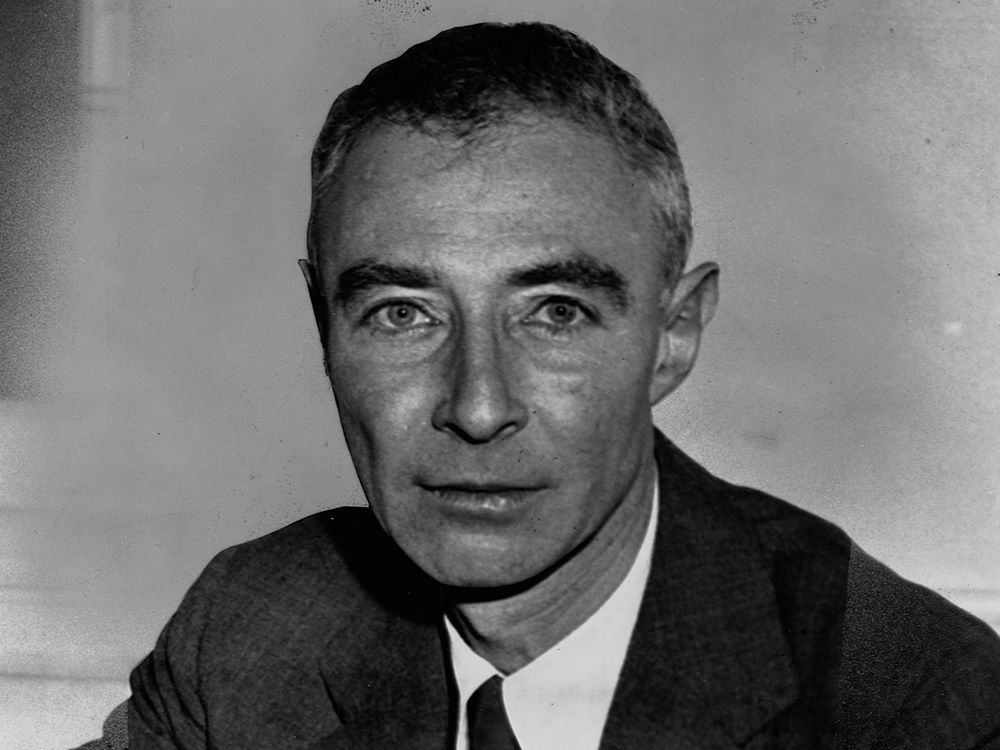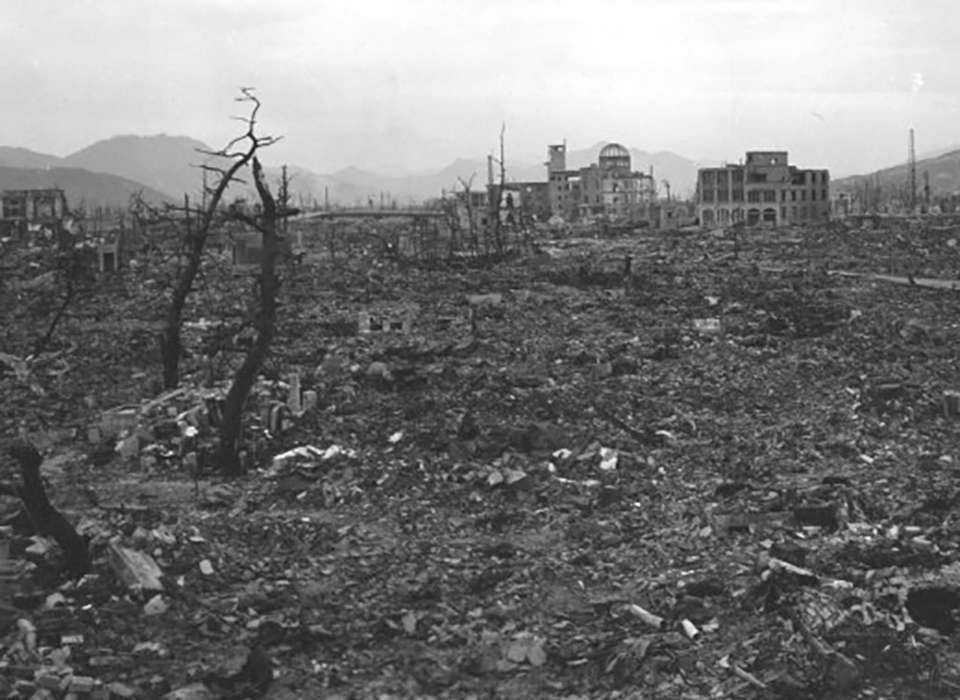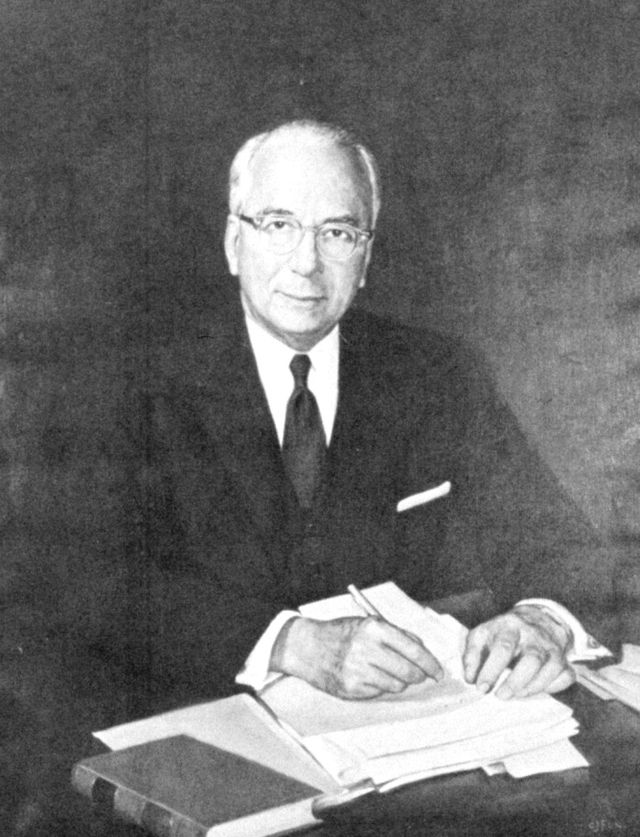As Julius Robert Oppenheimer witnessed the successful detonation of the world’s first nuclear weapon, he was haunted by its implications. In this article, we talk about Atomic Bomb Creator. Julius Robert Oppenheimer (1904-1967) was an American theoretical physicist. During the Manhattan Project, Oppenheimer was director of the Los Alamos Laboratory and responsible for the research and design of an atomic bomb. He is often known as the “father of the atomic bomb.”
Julius Robert Oppenheimer – “I remembered the line from the Hindu scripture, the Bhagavad Gita…Now I am become Death, the destroyer of worlds. I suppose we all thought that. One way or another”.
Oppenheimer was a man of many talents. He spoke eight languages. Wrote poetry. Yet he will forever be remembered as the father of the atomic bomb. The man who gave people the power to destroy themselves was haunted by his own creation. When people first met J. Robert Oppenheimer, what was immediately obvious to them was his intellect. A former colleague once said: “The man was unbelievable! He always gave you the right answer before you formulated the question.”
Knowledge came easy to Oppenheimer. He learned Dutch in six weeks just so he could give a lecture while on a visit to the Netherlands. He was born in New York on April 22, 1904, the older son of German Jewish immigrants. His father, Julius, was a textile importer who became very wealthy. His mother was a painter whose family had been in New York for generations. He was raised in Manhattan on the upper west side in an apartment adorned with paintings by famous artists, including Van Gogh.
After attending an elite private school in New York City, he went on to Harvard in 1922, intending to become a chemist but leaving with an appetite for physics. Ethical Culture Society School He had been attracted to experimental physics after taking a course on thermodynamics at Harvard. He also studied philosophy, Greek, and French literature. Ethical Culture School He spent his days living in the library, raiding the place intellectually, as he put it.
He enrolled at Harvard a year late due to suffering from colitis, an inflammatory bowel disease, but he made up for it by graduating in three years instead of four. He then crossed the pond to the University of Cambridge to conduct research at the Cavendish Laboratory for experimental physics. However, he was clumsy in the lab and realized his forte was not in experimental work but rather in theoretical physics.
The stress of grad work threw him into depression and he became emotionally unstable. He even confessed to lacing an apple with harmful chemicals in an attempt to poison his tutor with whom he didn’t get along. Fortunately, the tutor didn’t eat the apple. (Patrick Blackett) Oppenheimer left Cambridge to continue his studies at one of the centers of theoretical physics in Europe, the University of Göttingen (Goat-ting-in) in Germany.
He produced good work and held his own despite his youth. He was only 23 years old when he received his Ph.D. He subsequently returned to the U.S. where he worked as a research fellow at Harvard and then the California Institute of Technology, Caltech. He was so absorbed in his studies that he often ignored the real world. But the rise of fascism in Europe in the 1930s caught his attention.
Oppenheimer agreed with Einstein that German scientists could make a nuclear weapon and when they did, Hitler was prepared to use it. America watched fearfully as the Nazis invaded Poland in 1939. In 1942, Oppenheimer was selected to direct the Manhattan Project, a top-secret U.S. Army project to develop the atomic bomb. He brought together the best minds in physics and eventually managed more than 3,000 people.
He chose Los Alamos, New Mexico as the primary production facility because of its natural beauty. He had fallen in love with the mountains and plateaus when he traveled there as a teen during his gap year as he recovered from ill health. Washington threw ridiculous amounts of money at the project. An initial budget of $6,000 eventually ballooned into a whopping $2 billion by 1945!
Before heading the Manhattan Project, Oppenheimer taught physics at both Caltech and the University of California, Berkeley, where he built the physics program and turned it into the hub for physics research in America. He had already been working on nuclear fission – the powerful release of energy caused by the splitting of an atom. The best element for splitting is the heaviest element found in nature, uranium.
A uranium atom has 92 protons and 146 neutrons, giving an atomic mass of 238, or U238. A small portion of uranium that’s mined has the same 92 protons; however, it only has 143 neutrons, giving us U235. This is highly unstable, which makes it highly splitable or fissionable.
When it’s slammed by a neutron, it becomes U236. It’s so unstable that it splits into two atoms, krypton and barium. In the process, three more neutrons are released. They fly out and slam into more U-235 atoms, causing a chain reaction and ultimately a huge explosion. Kind of like when you throw a bowling ball and the pins jump and strike other pins, and those pins smash into other pins – all of the energy is released.
Research also showed that plutonium 239 would be highly fissionable. However, it’s not a naturally occurring element and had to be manufactured. Reactors were built in southeastern Washington state to produce the plutonium. And then….On July 16, 1945, scientists detonated a plutonium bomb over the small town of Alamagordo, New Mexico.
Julius Robert Oppenheimer – We knew the world would not be the same. A few people laughed. A few people cried. Most people were silent.
Never before had humanity possessed a weapon that posed a threat to global civilization. The test’s success meant an atomic bomb was ready to be used by the U.S. military. The following month, the U.S. military dropped two atomic bombs on Japan.
On August 6, 1945, the most powerful weapon in the world was dropped on the Japanese city of Hiroshima. 140-thousand people were killed, many vaporized. Thousands more would die in pain in the months and years that followed from radiation poisoning. Three days later, another bomb fell on Nagasaki, killing 74,000 people with equally devastating effects.
Japanese Emperor Hirohito decried the devastating power of “a new and most cruel bomb.” Japan surrendered six days later, abruptly ending World War Two. Oppenheimer initially expressed guilt over his creation. He said the weapon had “dramatized so mercilessly the inhumanity and evil of modern war.”
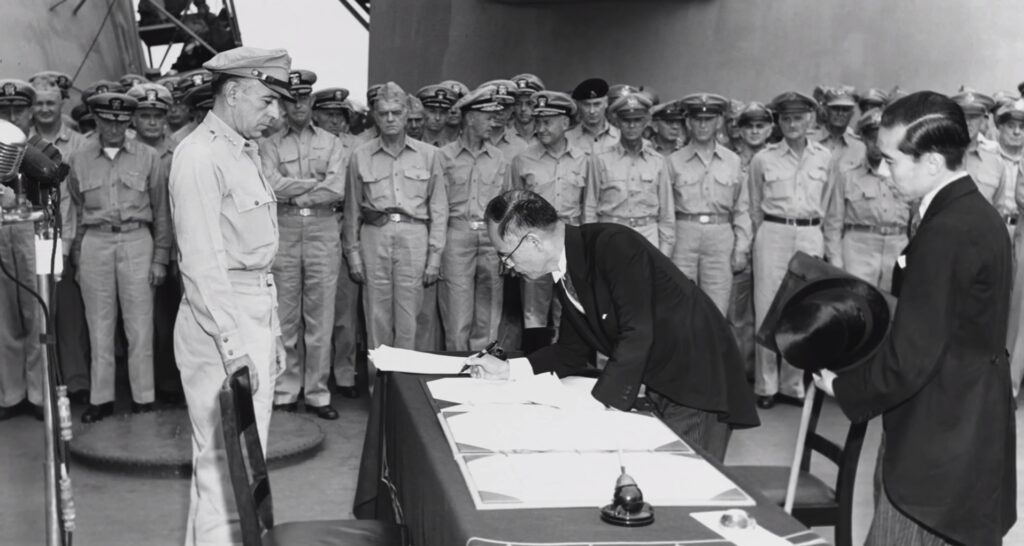
He continued: “In some sort of crude sense which no vulgarity, no humor, no overstatements can quite extinguish, the physicists have known sin; and this is a knowledge which they cannot lose.” Yet a decade later, he appeared to distance himself from personal responsibility, pinning it on the state, saying: ” I carry no weight on my conscience. Our work has changed the conditions in which men live, but the use made of these changes is the problem of governments, not of scientists.”
After the war, he became a key advisor on U.S. atomic policy. He headed the principal advisory committee of the successor to the Manhattan Project, the Atomic Energy Commission. The Commission was a civilian agency in control of nuclear research and the development of nuclear weapons. He even had a desk in the President’s Executive Office across the street from the White House. But then…things began to turn against Oppenheimer.
In December 1953, President Dwight Eisenhower ordered that a “blank wall be placed between Dr. Oppenheimer and any secret data.” Oppenheimer was suspected of being a communist spy. He argued he was never interested in politics and economics. He apparently wasn’t even aware of the stock market crash of 1929 until after the fact. However, he started connecting with left-leaning groups in the thirties and forties after falling for Jean Tatlock.
In 1936, friends introduced Oppenheimer to the grad student who was studying psychology at Stanford. Tatlock was extremely involved with politics. She was a member of the Communist Party of America and supported many left-leaning causes. Oppenheimer inherited hundreds of thousands of dollars after his father’s death in the thirties and began supporting left-wing efforts such as the Loyalists in the Spanish Civil War.
They had a passionate relationship and were together for several years, coming close to marriage, but ultimately broke up. He went on to marry Kitty Puening in 1940. She was a Berkeley student and was at one time a Communist Party member. They had two children together. He still continued to see his former love and spent a night with Tatlock while working on the secret bomb project in 1943.
Tatlock told him she still loved him. He never saw her again. She was a complicated person and is said to have struggled with her sexuality. She also suffered from intense depression and would take her own life in 1944. Perhaps it was Tatlock’s love of the English poet John Donne that compelled Oppenheimer to name the first test of the atomic bomb “Trinity”, inspired by Donne’s sonnet about a three-personed God.
Although Oppenheimer’s communist affiliations were clearly known – they didn’t stop him from getting hired on to lead the Manhattan Project. The FBI saw no reason to revoke his security clearance when they conducted an investigation in 1944. However, the onset of the Cold War brought renewed scrutiny. The Soviet Union conducted its first successful nuclear test in 1949, ahead of America’s estimates. People within the government were suspicious of Oppenheimer.
William Liscum Borden, executive director of the United States Congress Joint Committee on Atomic Energy, had sent a letter to FBI director J. Edgar Hoover concluding “more probably than not J. Robert Oppenheimer is an agent of the Soviet Union.” He didn’t back up his claim with any solid evidence. Borden was close to the chairman of the Atomic Energy Commission Lewis Strauss who hated Oppenheimer.
The two butted heads and Strauss never forgot when Oppenheimer humiliated him at a Congressional hearing years earlier. In 1954, Oppenheimer was called before a tribunal of the Atomic Energy Commission to explain his communist affiliations. It was a closed-door hearing that lasted four weeks. Oppenheimer maintained that he had not been radicalized by his ex-partner, and said his left-wing friends and associations simply gave him a sense of companionship – nothing more.
He had never been a Communist party member himself. Three board members heard his case. By a vote of two to one, they stripped him of his security clearance. The guy who delivered the verdict was none other than Strauss, who hated him. Oppenheimer was humiliated. The once powerful scientist lost all his power. The U.S. government no longer trusted the U.S. government’s top atomic physicist. His scientific peers were outraged.
Einstein quipped that the “AEC” in Atomic Energy Commission actually stood for “Atomic Extermination Conspiracy” Wernher von Braun, the chief architect of the Saturn V that got us to the moon, declared: “In England, Oppenheimer would have been knighted.”
But at least one scientist was pleased with the outcome. Hungarian physicist Edward Teller resented the fact that Oppenheimer resisted working on the hydrogen bomb – which is the more advanced version of an atomic bomb. When President Truman approached the Commission in 1949 about building a hydrogen bomb, Oppenheimer opposed it, to the anger of Teller.
The US pressed ahead with developing a thermonuclear weapon anyway and tested it in 1952 on the Marshall Islands. The H-bomb became Teller’s baby. During the Oppenheimer hearing, Teller testified: “I would feel personally more secure if public matters would rest in other hands.” For his testimony, Teller was shunned by the scientific community for many years.
Today, hundreds of declassified pages from the secret hearings have revealed Oppenheimer was not disloyal. The U.S. Department of Energy concludes “…it proved impossible to link his lack of enthusiasm for the hydrogen bomb with suspicions of his disloyalty.” Producing another weapon with the potential to be a thousand times more powerful than the atomic bomb was unfathomable to Oppenheimer.
He felt the hydrogen bomb was unnecessary and immoral, fearing its use against civilians. He had used his position on the Atomic Energy Commission to lobby for international control of nuclear weapons to avoid a nuclear arms race with the Soviet Union. With his security clearance revoked, he settled in Princeton, New Jersey where he still ran the Institute for Advanced Study, a research facility for postdoctoral fellows.
He lived quietly until President John F. Kennedy invited him to the White House dinner of Nobel Prize winners in 1962. Oppenheimer never won a Nobel prize himself, though he was nominated for the prize in Physics three times. When the Kennedy administration offered him a new trial to potentially get his security clearance back, he declined.
Further evidence that the government was warming up to him came in 1963 when President Johnson awarded him one of the highest scientific honors bestowed by a president, the Fermi Award, which comes with $50,000 tax-free. In response, Oppenheimer said: “I think it is just possible, Mr. President, that it has taken some charity and some courage for you to make this award today.”
Two years later, in 1965, Oppenheimer was diagnosed with throat cancer. He had been a notorious chain smoker all his life. The New York Times once described him “ as thin as the wisps from his chain-smoked cigarettes or pipes”. On February 18, 1967, he died at his home in Princeton. He was 62 years old. His wife took his ashes to the island of Saint John in the U.S. Virgin Islands, where he lived for several months of the year, and spread his ashes in the sea outside of their home, in an area known today as “Oppenheimer Beach.”
The twentieth century marked a new age in which the very existence of humankind was threatened. That threat is more real than ever today with fears that Russia could use nuclear weapons in Ukraine. North Korea’s missile launches in October were a simulation to “wipe out” South Korean targets, according to state media. The Doomsday Clock warns we are getting closer to destroying our world. At the beginning of the Cold War, we were 7 minutes to midnight. Today, we’re 100 seconds to midnight.
We hope you like my article about Atomic Bomb Creator who is Julius Robert Oppenheimer / Another name is the father of the atomic bomb. Please share / bookmark and link.
You Might Like-
Knowledge World Blog- WWW.KNOWLEDGEWORLD.BLOG
Visit Our Online Shop Website- WWW.CEYLEBRITY.COM
Ceylebrity Sinhala News- WWW.CEYLEBRITYNEWS.LK
Share
